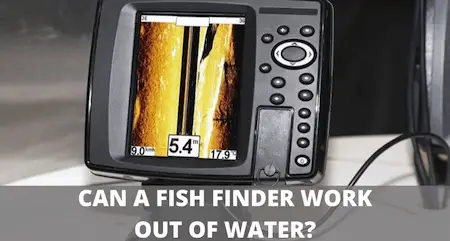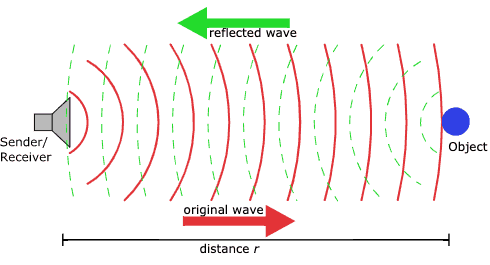Can You Use A Fish Finder Out Of Water?
UPDATED 17 MAY 2023
by Robert Ceran
A question I get surprisingly often is this: “Can you use a fish finder out of water?”
Here’s the quick answer:
No, you can’t use a fish finder out of water, because the transducer is unable to send or receive sonar signals in air.
In other words, the transducer will not work outside of water, and needs to be properly submerged into water in order to function.
The only exception to this rule are transducers that are set up to work through an appropriate solid substance, which is in turn connected to water.

For example, some models can send and receive sound signals through fiberglass boat hulls, and if set up correctly, regular transducers can shoot through ice.
But even in those cases, you have to make sure there’s no air between the transducer and the hull surface, as this will effectively block the sonar signaling ability.
Why fish finders work in water, but not in air
Fish finders detect objects underwater by using sonar signaling (for more details read our article on how does a fish finder work?). Sonar is an abbreviation for SOund NAvigation and Ranging, which describes a technology that relies on sending and receiving sound signals.

Principle of sonar signaling (Source: Georg Wiora, CC BY-SA)
In other words, the transducer of a depth finder acts both as a loudspeaker (sending sound pulses) and as a microphone (receiving returned sound pulses).
The returned sound signals are interpreted by the processing unit and displayed on the screen, which can be used to locate fish. Check out our article on how to read a fish finder for more information.
Water is a much denser medium compared to air. Because of this, air only supports the propagation of short wavelength signals, such as radar, while dissipating longer wavelength signals, such as sonar.
Conversely, water supports the propagation of long wavelength signals such as sonar, while effectively absorbing shorter wavelengths.
Can you run a transducer out of the water?
It’s possible to run a transducer out of the water, but its sonar signaling capability won’t work under these conditions, which means you’re not going to get any benefit from turning it on.
As already mentioned, the only exception to this is that you can shoot through ice. However, even in that case it’s better to use a flasher with an ice fishing transducer, since they are specifically designed for this purpose (for more on this, check out our review of the best ice fishing fish finders and flashers).
Now, I’m understand that some depth finders have a radio, and you might want to turn this on while you’re out of the water and not using the sonar. In that case, use the menu of the display to turn off the transducer, so only the main display unit is on.
Is it bad to turn on a fish finder out of the water?
It’s not a good idea to turn on your transducer out of the water, since most models rely on water to cool them off, which causes them to heat up quickly when run in air. Especially CHIRP models send a lot of energy pulses, and heat up quickly when run out of the water, which can destroy their function by fracturing the piezoelectric crystals.
This is why you should really make sure to avoid turning them on out of the water. If you really want to run your depth finder out of water for some reason, make sure to turn off the transmitter output of the transducer to avoid damaging it. You can easily double check this by touching it to test if it’s getting hot or not.
If you think your transducer might have been damaged, and isn’t working properly, check out our article on how to tell if your transducer is bad.
Can you test a fish finder out of water?
While it’s possible to run your depth finder out of the water, you won’t be able to test its ability to perform sonar signaling, since this doesn’t work in air, as explained above.
So, if you try to run it out of the water, you’ll get a depth reading that doesn’t make any sense, such as 1200 ft. of water in your backyard. This happens because the transducer tries to send and receive sound signals as if it were submerged in water, but is only able to pick up random noise, which the processor can’t interpret correctly.
Also, as mentioned above, turning on your depth finder out of water can damage the transducer, so it’s definitely not a good way to test it.
Can you test a transducer in a bucket of water?
If you submerge the transducer in a bucket of water, you’ll probably also get a depth reading that doesn’t make sense, such as 0 ft., since most models need at least 3-4 ft. of water depth in order to function properly. So, for a meaningful test you should aim to run your model in water that’s at least 4 ft. deep to see if you’re getting an accurate reading.
Can you mount a transducer inside the boat hull?
Yes, this is possible with some models, but only on boats that have a pure fiberglass hull. The sound signal is able to propagate through the fiberglass and into the water. However, you need to make sure there’s no air between the transducer and the hull.
In order to achieve this, you can glue it directly to the hull with epoxy, or you can glue an open ended pipe to the hull, fill it with water, and then submerge your transducer into this. Make sure you choose a spot on the hull which is in direct contact with water on the outside.
Conclusion
Fish finders are designed to work in water, and not in air. As such I would advise against turning them on out of the water, even if it’s just for a test.
Also, when you’re about to take your boat out of the water, make sure you turn off the depth finder before you do so, to avoid damaging it.
If you’re looking in to buying a new fish finder, take a look at our review of the top fish finder under $300.
Or if you’re interested in more high end features, check out our review on the Garmin Striker 7SV.
